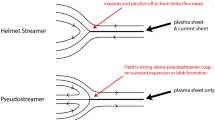Abstract
Using three-dimensional (3D) magnetohydrodynamical (MHD) nested-grid simulations, the fragmentation of a rotating magnetized molecular cloud core is studied. An isothermal rotating magnetized cylindrical cloud in hydrostatic balance is considered. We studied non-axisymmetric evolution of the cloud. It is found that non-axisymmetry hardly evolves in the early phase, but it begins to grow after the gas contracts and forms a thin disk. The disk formation and thus growth of non-axisymmetric perturbation are strongly promoted by rotation and magnetic field strength. We found two types of fragmentations: fragmentation from a ring and that from a bar. These two types of fragmentations occur in thin adiabatic cores with the thickness being smaller than 1/4 of the radial size. For the fragments to survive, they should be formed in a heavily elongated barred core or a flat round disk. In the models showing fragmentation, outflows from respective fragments are found as well as that driven by the rotating bar or the disk.
Similar content being viewed by others
References
Abt, H. A.: 1983, ARA&A 21, 343.
Boss, A. P.: 1993, ApJ 410, 157.
Boss, A. P.: 2002, ApJ 568, 743.
Boss, A. P. and Myhill, E. A.: 1995, ApJ 451, 218.
Duquennoy, A. and Mayor, M.: 1991, A&A 248, 485.
Fukuda, F. and Hanawa, T.: 1999, ApJ 517, 226.
Kroupa, P. and Burkert, A.: 2001, ApJ 555, 945.
Larson, R. B.: 1969, MNRAS 145, 271.
Machida, M. N.: 2003, Binary Star Formation and Mass Outflow in the Molecular Cloud Core, PhD thesis, Hokkaido U.
Matsumoto, T., Hanawa, T. and Nakamura, F.: 1997, ApJ 478, 569.
Matsumoto, T., Nakamura, F. and Hanawa, T.: 1994, PASJ 46, 243.
Miyama, S. M., Hayashi, C. and Narita, S.: 1984, ApJ 279, 621.
Nakamura, F. and Hanawa, T.: 1997, ApJ 480, 701.
Norman, M. L., Wilson, J. R. and Barton, R. T.: 1980, ApJ 239, 968.
Stodólkiewicz, J. S.: 1963, Acta Astron. 13, 30.
Tohline, J. E.: 1982, Fundam. Cosm. Phys. 8,1
Tomisaka, K.: 1995, ApJ 438, 226.
Tomisaka, K.: 1998, ApJ 502, L163.
Tomisaka, K.: 2000, ApJ 528, L41.
Tomisaka, K.: 2002, ApJ 575, 306.
Truelove, J. K., Klein, R. I., Mckee, C. F., Holliman, J. H., Howell, L. H. and Greenough, J. A.: 1997, ApJ 489, L179.
Tsuribe, T. and Inutsuka, S.: 1999, ApJ 523, L155.
Author information
Authors and Affiliations
Rights and permissions
About this article
Cite this article
Tomisaka, K., Machida, M.N. & Matsumoto, T. Contraction and Fragmentation of Magnetized Rotating Clouds and Formation of Binary Systems. Astrophysics and Space Science 292, 309–316 (2004). https://doi.org/10.1023/B:ASTR.0000045032.47925.54
Issue Date:
DOI: https://doi.org/10.1023/B:ASTR.0000045032.47925.54



